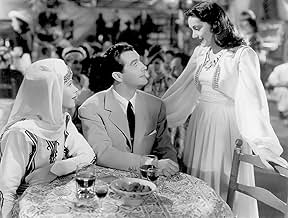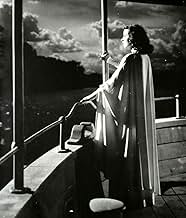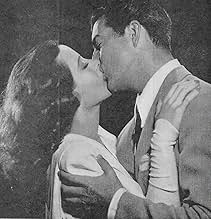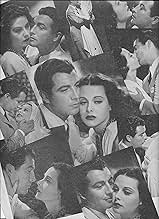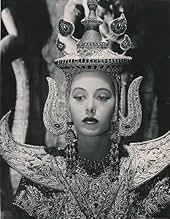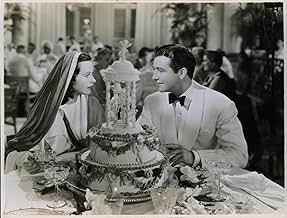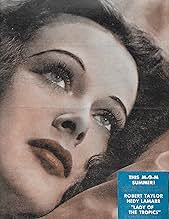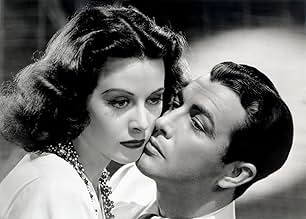NOTE IMDb
6,1/10
731
MA NOTE
Ajouter une intrigue dans votre languePlayboy Bill Carey woos a half-caste beauty in French Indochina, but her second-class legal status makes a formidable barrier.Playboy Bill Carey woos a half-caste beauty in French Indochina, but her second-class legal status makes a formidable barrier.Playboy Bill Carey woos a half-caste beauty in French Indochina, but her second-class legal status makes a formidable barrier.
- Réalisation
- Scénario
- Casting principal
- Récompenses
- 1 victoire au total
Marguerita Padula
- Madame Kya
- (as Margaret Padula)
Leon Belasco
- Assistant to Manager
- (non crédité)
Abner Biberman
- Wardrobe Buyer
- (non crédité)
Gino Corrado
- Waiter
- (non crédité)
Vernon Downing
- Ship Passenger
- (non crédité)
Willie Fung
- Ling
- (non crédité)
Charles Halton
- Manager of Rubber Company
- (non crédité)
Avis à la une
With a script by Ben Hecht, LADY OF THE TROPICS is a film that recalled another Hedy Lamarr film--at least the title does--called "A Lady Without Passport"--a wretched film she made in 1950. Here too, she's a lady without passport and that's what triggers the entire plot. But it must be said that the comparison between the two films ends with the title.
This is strictly old-fashioned melodrama reeking of either "Manon Lescaut" or "Madame Butterfly", with Hedy as the ill-fated heroine who allows herself to be "used" by Joseph SCHILDKRAUT while hiding her indiscretions from her smitten American admirer (ROBERT TAYLOR), who meets her in French Indochina (Saigon) before WWII and immediately falls in love with her. When Schildkraut gets revenge by planting false evidence of his association with Lamarr to open Taylor's eyes to the truth, the consequences turn tragic.
Hedy has never been more beautiful and gives a sensitive performance as Manon (yes, that's her name!), a "lady of the tropics" with a sultry beauty enhanced by her MGM transformation into a stunning star who is always ready for her close-ups. Attired in an equally stunning Adrian wardrobe, she's a glittering testament to the power of Golden Age films to give stars glamor with a capital "G". Taylor, attired in white linen suits and Panama hats must have made female hearts flutter as the romantic hero willing to sacrifice all for his yen for Manon.
It's a better film than I expected. Joseph SCHILDKRAUT makes a perfect villain, the kind you like to hiss, with his Oriental make-up and oily manner oozing menace at every quiet inflection of his voice. The B&W photography of some artfully designed sets is soothing to the eye and so, of course, is the teaming of Lamarr and Taylor--two of the most photogenic stars on the MGM lot.
The script by Ben Hecht helps sustain interest in the storyline, even if it does get a bit too weepy toward the end. Lamarr shows evidence that she could be a very sympathetic heroine if given half a chance.
This is strictly old-fashioned melodrama reeking of either "Manon Lescaut" or "Madame Butterfly", with Hedy as the ill-fated heroine who allows herself to be "used" by Joseph SCHILDKRAUT while hiding her indiscretions from her smitten American admirer (ROBERT TAYLOR), who meets her in French Indochina (Saigon) before WWII and immediately falls in love with her. When Schildkraut gets revenge by planting false evidence of his association with Lamarr to open Taylor's eyes to the truth, the consequences turn tragic.
Hedy has never been more beautiful and gives a sensitive performance as Manon (yes, that's her name!), a "lady of the tropics" with a sultry beauty enhanced by her MGM transformation into a stunning star who is always ready for her close-ups. Attired in an equally stunning Adrian wardrobe, she's a glittering testament to the power of Golden Age films to give stars glamor with a capital "G". Taylor, attired in white linen suits and Panama hats must have made female hearts flutter as the romantic hero willing to sacrifice all for his yen for Manon.
It's a better film than I expected. Joseph SCHILDKRAUT makes a perfect villain, the kind you like to hiss, with his Oriental make-up and oily manner oozing menace at every quiet inflection of his voice. The B&W photography of some artfully designed sets is soothing to the eye and so, of course, is the teaming of Lamarr and Taylor--two of the most photogenic stars on the MGM lot.
The script by Ben Hecht helps sustain interest in the storyline, even if it does get a bit too weepy toward the end. Lamarr shows evidence that she could be a very sympathetic heroine if given half a chance.
Truly I don't understand the poor reviews of this film.
It's a melodramatic romance in the vein of "Camille" or "Waterloo Bridge." (Both of which also starred Robert Taylor). It is certainly no worse than those, and the overall theme is not that much different.
Hedy Lamarr's role here is very subtly played. She lies and deceives because she doesn't want anyone to be hurt. That is key to understanding her character. Placed in an impossible situation, Manon tries her best to rise above it the only way she knows how. Lamarr captures this struggle magnificently. It's written on her face in so many scenes.
Sometimes I've heard she is "wooden" in this role. Are you kidding? In her scenes with evil Delaroch, she masks her agony with a Mona Lisa smile, trying to reveal nothing. That is acting, folks. Sorry you don't recognize it. Perhaps it is because so many stars of the era regularly chewed the scenery, and in comparison, Lamarr's portrayal is too realistic. It's the only thing I can fathom.
As for Robert Taylor, also a favorite of mine...I think he plays the American playboy perfectly. One of my favorite scenes is where he's trying to buy a "hat" for his heiress girlfriend early in the film. He supplies humor in just the right amounts, and his eventual adoration of Manon is well done, hauntingly.
I have seen this movie probably more than any others of hers, and I never get tired of it.
It's a melodramatic romance in the vein of "Camille" or "Waterloo Bridge." (Both of which also starred Robert Taylor). It is certainly no worse than those, and the overall theme is not that much different.
Hedy Lamarr's role here is very subtly played. She lies and deceives because she doesn't want anyone to be hurt. That is key to understanding her character. Placed in an impossible situation, Manon tries her best to rise above it the only way she knows how. Lamarr captures this struggle magnificently. It's written on her face in so many scenes.
Sometimes I've heard she is "wooden" in this role. Are you kidding? In her scenes with evil Delaroch, she masks her agony with a Mona Lisa smile, trying to reveal nothing. That is acting, folks. Sorry you don't recognize it. Perhaps it is because so many stars of the era regularly chewed the scenery, and in comparison, Lamarr's portrayal is too realistic. It's the only thing I can fathom.
As for Robert Taylor, also a favorite of mine...I think he plays the American playboy perfectly. One of my favorite scenes is where he's trying to buy a "hat" for his heiress girlfriend early in the film. He supplies humor in just the right amounts, and his eventual adoration of Manon is well done, hauntingly.
I have seen this movie probably more than any others of hers, and I never get tired of it.
I remember when I was living in Vietnam, I was told that Eurasian women were the most beautiful in the World. The French-Vietnamese women that I saw were indeed exquisite. Hedy Lamarr was perfectly caste as one of these women, and her performance in this film was so romantic that one would want to see it over and over.
This fine film featured Oscar-nominated cinematography, a script by the great Ben Hecht (Wuthering Heights, Notorious, The Scoundrel, Underworld), and Robert Taylor as the leading man.
The story is as old as time and you cannot fail to be moved by the tragedy.
This fine film featured Oscar-nominated cinematography, a script by the great Ben Hecht (Wuthering Heights, Notorious, The Scoundrel, Underworld), and Robert Taylor as the leading man.
The story is as old as time and you cannot fail to be moved by the tragedy.
Was Ben Hecht a damnable racist, or does it merely seem so? The fact that this frankly racist film doesn't shock our sensibilities maybe due to its not being that much outside of the norm. Hollywood has been called leftist, but no miscegenation is allowed, not even after the war. And all participants in this charade pretend to have creative freedom, or to desire it. This film could well have been called "No Miscegenation!" at a time when someone else in Europe was crying "No Miscegenation!" Congratulations Hollywood!
Hedy Lamarr was not generally as fortunate in her scripts or her directors as most of the great leading ladies of her day.Yet this now almost forgotten film may ,in fact, be her most perfect vehicle. "Samson and Delilah" appears the only alternative possibility ;still the gentler less garish approach here serves to better accentuate Miss Lamarr's exquisite beauty and muted, perfectly timed, performance.
The part of the half-caste Manon seems written for her (an excellent Ben Hecht script); the photography deserved its Oscar nomination and makes us ask for what do we need technicolor? Furthermore,Lamarr is ably seconded by then newcomer Gloria Franklin as another gentle victim of the Saigon love game.And can Miss Franklin handle a heartbreaking rhythm. Why did America fail to take this delicate chanteuse to its heart?
The main flaw in this work,which otherwise would deserve a nine or ten rating, is the casting of an already hardening Robert Taylor as the enraptured playboy.It is patent,considering the obvious parallels with "Camille, why Taylor was hired. He even goes through some almost identical motions a second time in the death scene here. And that is exactly the problem.Taylor has left romanticism behind him by the time this film was shot. His best notes here are quiet desperation. Francis Lederer would have been great for the role(remember him with Louise Brooks?),but, under the Hollywood casting system ,there was no chance he could have gotten the part.
Flawed as it is, it is flawless Lamarr.And as every romantic believes ,there must still be audiences of unknowing lovers out there who will want to see it again-and again.
The part of the half-caste Manon seems written for her (an excellent Ben Hecht script); the photography deserved its Oscar nomination and makes us ask for what do we need technicolor? Furthermore,Lamarr is ably seconded by then newcomer Gloria Franklin as another gentle victim of the Saigon love game.And can Miss Franklin handle a heartbreaking rhythm. Why did America fail to take this delicate chanteuse to its heart?
The main flaw in this work,which otherwise would deserve a nine or ten rating, is the casting of an already hardening Robert Taylor as the enraptured playboy.It is patent,considering the obvious parallels with "Camille, why Taylor was hired. He even goes through some almost identical motions a second time in the death scene here. And that is exactly the problem.Taylor has left romanticism behind him by the time this film was shot. His best notes here are quiet desperation. Francis Lederer would have been great for the role(remember him with Louise Brooks?),but, under the Hollywood casting system ,there was no chance he could have gotten the part.
Flawed as it is, it is flawless Lamarr.And as every romantic believes ,there must still be audiences of unknowing lovers out there who will want to see it again-and again.
Le saviez-vous
- AnecdotesThe American Film Institute Catalog of Feature Films 1931-1940 states that this was Hedy Lamarr's last film under her MGM contract; it was her first. AFI also adds that Mary Taylor was signed to a long-term MGM contract as a result of her work in this picture; in fact, she would be seen in only four feature films in her entire career, and only one more of them, Les oubliés (1941) would be made at MGM.
- Citations
Bill Carey: Father... Father, help us.
Father Antoine: My son, she goes where there is no east or west. And she will be judged by one who alone knows how great or how little were her sins.
- ConnexionsFeatured in From the Ends of the Earth (1939)
- Bandes originalesEach Time You Say Goodbye (I Die A Little)
(1939)
Music by Phil Ohman
Lyrics Foster Carling
Sung by Gloria Franklin (uncredited) (dubbed by Harriet Cruise (uncredited))
Meilleurs choix
Connectez-vous pour évaluer et suivre la liste de favoris afin de recevoir des recommandations personnalisées
- How long is Lady of the Tropics?Alimenté par Alexa
Détails
Box-office
- Budget
- 913 000 $US (estimé)
- Durée
- 1h 32min(92 min)
- Couleur
- Rapport de forme
- 1.37 : 1
Contribuer à cette page
Suggérer une modification ou ajouter du contenu manquant


